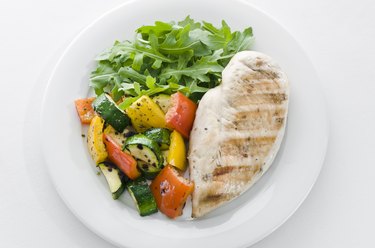
Monitoring your food portions is a great way to control your weight and maintain good health. This can be tricky if you don't have a food scale, though. By using a few simple household items or even your own body, you can estimate the portion sizes of many of your favorite foods.
Tip
Measuring food with your hands or using household items is an easy replacement for a scale.
Video of the Day
Know the Guidelines
Before you start estimating portion sizes with your hand or objects around the house, it's important to know how many servings of each food type are recommended. According to the American Heart Association, healthy adults should eat about five servings of vegetables and four servings of fruit each day.
Video of the Day
Additionally, six servings of grains (like bread, uncooked pasta, rice or cereals) and three servings of dairy (including milk, yogurt and cheese) are considered to be the norm for most adults. Fats and oils, such as mayonnaise and salad dressings, should be consumed less frequently (up to three servings per day).
Furthermore, eight to nine servings of protein like poultry, meat or eggs and two to three servings of seafood can also be consumed over the course of the week. These numbers are just guidelines, however, and each individual's dietary needs may be slightly different. It all comes down to your health and fitness goals and activity level.
Measuring Food With Hands
Now that you know the general recommendations, the next step is to portion out your meal. Without a food scale, though, this may seem difficult. Fortunately, some of the best tools are right in front of you.
Estimating portion sizes with your hand is an easy way to visualize how much you should be eating. The Dietitians of Canada recommend using the palm of your hand to estimate the approximate size of one serving of fish, meat, poultry or grains (like a bagel or piece of bread).
A cupped fist is roughly the size of a serving of legumes, nuts, beans, yogurt or milk. The fist can also be used to measure a serving of cereal, pasta, rice, vegetables or fruit.
Finally, don't forget about using your fingers to measure food with hands. A proper serving of peanut butter or cheese is roughly equivalent to the size of two of your thumbs. The British Heart Foundation suggests using a fingertip to estimate the proper portion of butter.
Look Around the House
If measuring food with hands doesn't sound precise enough, you can also use common household items in place of an actual food scale to measure your portions. According to the Academy of Nutrition and Dietetics, a standard baseball is equal to a serving of raw or cooked vegetables, fruit or a cup of 100 percent fruit juice.
A tennis ball is about the size of a half-cup of food — that's about one portion of grains like pasta, rice or oatmeal. Another common item, a deck of cards, can also be used in place of a food scale to represent a serving of fish, poultry or other types of meat.
Finally, a postage stamp (which is roughly equivalent to one tablespoon) is a good visual to measure a portion of fats and oils. This is helpful when determining how much salad dressing or mayo to add to your meal.
Portion It Out
Whether you're estimating portion sizes with your hand or using common objects you have around your home, it's important to stay diligent with your portion control. In many cases, people underestimate the number of servings in their favorite meals and end up consuming far more food than they bargained for. This is especially true when you eat out at a restaurant, where portions have become extremely bloated in size.
Carefully adhering to the American Heart Association's dietary guidelines and measuring food with hands or other items can help prevent overeating. It may also help you avoid gaining extra pounds.
If you are struggling to maintain a healthy weight in spite of this or if you have other health conditions that affect your daily nutritional intake, it's best to speak with your doctor or dietitian. They can recommend an appropriate eating plan that is specifically tailored to your needs and goals.